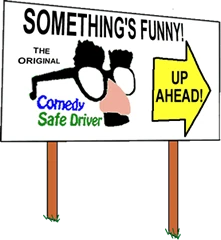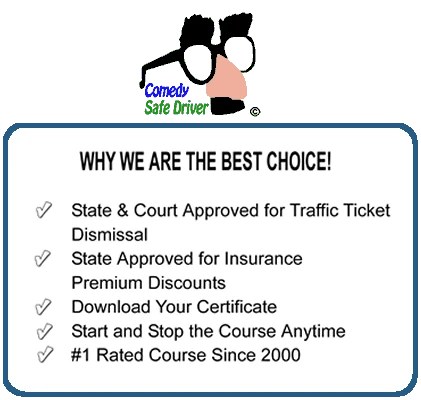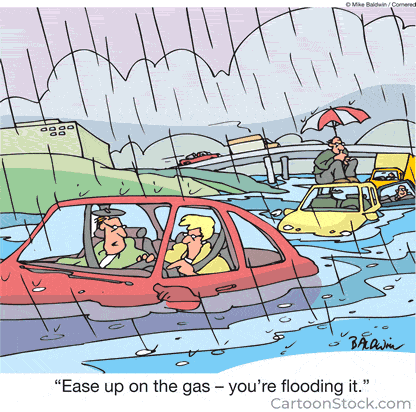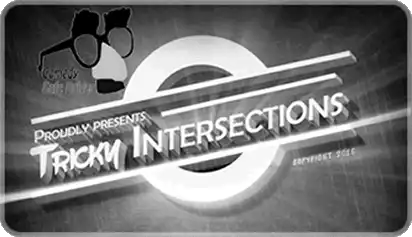
NM DOT Defensive Driving Course
About Comedy Safe Driver's NM DOT Defensive Driving Course
The NM Dot Defensive Driving Course is a unique program designed to enhance your driving skills, keeping you safe on the road. This course, unlike any other, combines the essential elements of defensive driving with a touch of humor, making the learning process not just informative but also enjoyable.
Our course is fully approved by the New Mexico Department of Transportation, ensuring that it meets the highest standards of driver education. Whether you're a new driver or an experienced one looking to refresh your skills, the NM Dot Defensive Driving Course is perfect for you.
Why Choose NM Dot Defensive Driving Course?
Choosing the NM Dot Defensive Driving Course is choosing safety, knowledge, and fun. Our course is designed to provide you with practical knowledge about New Mexico's road rules and safe driving practices. Plus, our unique comedic approach makes the learning process engaging and memorable.
By signing up for our course, you'll learn how to anticipate and respond to potential hazards on the road, understand New Mexico's traffic laws, and develop safe driving habits that will last a lifetime.
Safe Driving Tips
While our course provides comprehensive training, here are a few safe driving tips to keep in mind:
-
Always wear your seatbelt: When you're behind the wheel, safety should always be your top priority. The first and foremost rule of ensuring this safety is to always wear your seatbelt. Why is this so crucial? Here's why:
-
Protection During Collisions: Accidents can happen unexpectedly, no matter how skilled a driver you are. Seatbelts are specifically engineered to offer protection during these unforeseen events. They act as a shield, reducing the severity of injuries you might sustain during a collision.
-
Preventing Ejections: One of the most dangerous outcomes of a car crash is being ejected from the vehicle. This can lead to severe injuries or even fatalities. Seatbelts play a pivotal role in keeping you inside the car, significantly decreasing the chances of being thrown out during an accident.
-
Distributing Impact Force: Imagine the sudden jolt and force your body would experience during a crash. Without a seatbelt, this force can be concentrated on a particular part of your body, leading to severe injuries. Seatbelts are designed in such a way that they spread this force across the sturdier parts of your body, like your chest and pelvis. This distribution minimizes the risk of concentrated injuries.
Seatbelts are not just a piece of fabric; they're life-saving tools. They've been meticulously designed over the years to offer maximum protection. So, every time you get into a car, whether you're driving or just a passenger, remember to buckle up. It's a simple act that can make a world of difference in ensuring your safety.
-
-
Keep a safe distance from the vehicle in front of you: Driving isn't just about controlling your own vehicle; it's also about anticipating the actions of others on the road. One of the key principles to ensure safety while driving is to keep a safe distance from the vehicle in front of you. Here's a more detailed look at why this is so essential:
-
Time to React: On the road, situations can change in the blink of an eye. If the car ahead of you brakes suddenly or encounters an obstacle, having a safe following distance ensures you have ample time to react. This buffer can be the difference between a close call and a collision.
-
Better Visibility: By maintaining a good distance, you have a clearer view of the road ahead. This allows you to see potential hazards or changes in traffic conditions earlier, giving you more time to prepare and adjust your driving accordingly.
-
Reduced Risk of Rear-end Collisions: One of the most common types of accidents is rear-end collisions. By ensuring you're not tailgating the vehicle in front, you significantly reduce the risk of being involved in such an accident.
-
Adapting to Conditions: While the two-second rule is a good general guideline for ideal conditions, it's crucial to adjust based on the situation. For instance, in rain, fog, or snow, visibility and road grip can be compromised. In such scenarios, increasing your following distance gives you even more time to react to unforeseen events.
-
Less Stress: Keeping a safe distance can also reduce driving stress. When you're too close to another vehicle, you constantly have to adjust your speed to match theirs. By maintaining a buffer, you can drive more smoothly and with less anxiety.
Maintaining a safe following distance isn't just a recommendation; it's a fundamental practice for safe driving. It provides you with the necessary space and time to make crucial decisions, potentially preventing accidents and ensuring the safety of everyone on the road. Always be mindful of the distance between you and the car ahead, and adjust it based on the driving conditions you're facing.
-
-
Observe and respect speed limits: Speed limits aren't just arbitrary numbers posted on signs; they're carefully calculated guidelines meant to ensure safety on the roads. Here's a more comprehensive look at why adhering to these limits is crucial:
-
Safety First: Speed limits are primarily set with safety in mind. They take into account various factors like the design of the road, the kind of vehicles that use it, and the surrounding environment. By sticking to the speed limit, you're adhering to a speed that's been deemed safe for that particular stretch of road.
-
Reduced Accident Severity: The faster a vehicle is moving, the more severe an accident can be if it occurs. Higher speeds mean more kinetic energy, which translates to more force during a collision. By observing speed limits, you're reducing the potential severity of any accident that might occur.
-
Improved Reaction Time: At higher speeds, your reaction time is significantly reduced. This means that if an unexpected event occurs, like a pedestrian crossing or another vehicle braking suddenly, you have less time to respond. Staying within the speed limit ensures you have adequate time to react to unforeseen situations.
-
Protecting Vulnerable Road Users: Roads aren't just for cars. They're used by pedestrians, cyclists, and sometimes even animals. Driving at or below the speed limit ensures that you have enough time to spot and safely navigate around these vulnerable road users.
-
Avoiding Penalties: Beyond the safety aspects, exceeding speed limits can lead to traffic violations, which might result in fines, points on your license, or even suspension of driving privileges. Respecting speed limits helps you avoid these legal repercussions.
-
Fuel Efficiency: Driving at consistent and moderate speeds can actually improve your vehicle's fuel efficiency. Speeding, on the other hand, can lead to more fuel consumption and increased wear and tear on your vehicle.
-
Community Well-being: In residential areas, speed limits are often set lower to protect residents, especially children. By observing these limits, you're contributing to the well-being of the community and ensuring a safer environment for everyone.
Speed limits are more than just numbers; they're a reflection of the collective wisdom and experience of traffic experts, engineers, and safety professionals. Respecting them is not just about obeying the law; it's about ensuring the safety of yourself, your passengers, and everyone else on the road. So, the next time you're tempted to press harder on the accelerator, remember the broader implications of your actions and choose safety over speed.
-
-
Never drink and drive: Driving requires a high level of concentration, coordination, and quick decision-making. Alcohol, even in small amounts, can significantly hinder these abilities. Here's a more detailed exploration of why drinking and driving is such a dangerous combination:
-
Impaired Judgment: Alcohol can cloud your judgment, making you overconfident and leading you to take unnecessary risks. You might think you're driving perfectly fine, but in reality, your reflexes and decision-making abilities are compromised.
-
Slowed Reaction Time: Alcohol slows down the brain's processing speed. This means that your ability to respond to sudden changes or emergencies on the road is drastically reduced. A situation that you could normally handle with ease can become deadly when alcohol is in your system.
-
Reduced Coordination: Alcohol affects your motor skills. This can lead to difficulty steering, a lack of coordination between your hands and feet, and an inability to gauge distances accurately.
-
Blurred Vision: Alcohol can blur your vision or make it difficult to judge distances and speeds. It can also reduce your peripheral vision, making it harder to see obstacles or other vehicles approaching from the side.
-
Drowsiness: Alcohol is a depressant, which means it can make you feel drowsy or fatigued. Falling asleep at the wheel, even for a split second, can have catastrophic consequences.
-
Legal Consequences: Beyond the safety risks, driving under the influence can lead to severe legal penalties, including hefty fines, loss of your driver's license, and even imprisonment. Moreover, if you cause an accident while drunk, you could face severe legal repercussions and lifelong guilt.
-
Endangering Others: When you drink and drive, you're not just putting your own life at risk. You're endangering everyone else on the road, including other drivers, pedestrians, and cyclists. It's a responsibility that no one should take lightly.
-
Easy Alternatives: In today's world, there's no excuse for drinking and driving. With the availability of taxis, ride-sharing services, and public transportation, there are numerous safer alternatives. If you plan on drinking, always arrange for a sober ride home.
The message is clear and uncompromising: Never drink and drive. No destination or urgency is worth the potential loss of life or the irreversible damage that can result from such a decision. Always prioritize safety, both for yourself and for everyone else on the road. If you've consumed alcohol, always choose a safer alternative to get home.
-
-
Be aware of your surroundings and anticipate potential hazards: Safe driving involves more than just focusing on the car in front of you. You should also be aware of what's happening on the sides and behind your vehicle. Regularly check your mirrors and be alert for potential hazards, like pedestrians, cyclists, and other drivers.
-
Follow New Mexico's traffic laws and regulations: Every state in the U.S. has its unique traffic laws, tailored to its specific needs, geography, and traffic patterns. New Mexico is no exception. Understanding and following these laws is paramount for several reasons:
-
Safety First: The primary purpose of traffic laws is to ensure the safety of all road users. Whether it's setting speed limits, dictating right-of-way, or establishing guidelines for traffic signals, these rules are designed based on extensive research and understanding of local conditions to prevent accidents and ensure smooth traffic flow.
-
Consistency: For drivers, consistency is key. When everyone follows the same set of rules, it becomes easier to predict the actions of other road users. This predictability reduces confusion and the chances of accidents.
-
Avoiding Legal Repercussions: Ignoring or violating traffic laws can lead to various penalties, ranging from fines and demerit points on your license to more severe consequences like license suspension or even jail time, depending on the severity of the violation.
-
Protecting Vulnerable Road Users: New Mexico's traffic laws also cater to the safety of pedestrians, cyclists, and motorcyclists. By adhering to these rules, drivers ensure that these vulnerable road users are protected and can safely share the road.
-
Cultural Respect: Respecting and following local laws is also a sign of respect for the community and culture of New Mexico. It shows that you value the safety and well-being of its residents.
-
Adapting to Local Conditions: New Mexico has a diverse landscape, from bustling cities to vast deserts and mountainous regions. Its traffic laws take into account these varied conditions, ensuring that drivers are prepared for any scenario they might encounter.
-
Staying Informed: Traffic laws can change. It's essential to stay updated on any new regulations or modifications to existing ones. This not only ensures that you're always in compliance but also that you're aware of any new safety measures or guidelines introduced.
While it might be tempting to think that driving is the same everywhere, the nuances of local traffic laws can make a significant difference. Whether you're a resident of New Mexico or just passing through, it's your responsibility to familiarize yourself with its traffic regulations. Remember, being informed and following the rules isn't just about avoiding penalties; it's about ensuring the safety of yourself and everyone else on the road.
-
Remember, these tips are just a starting point. Our comprehensive driving course will provide you with a more in-depth understanding of safe driving practices.















